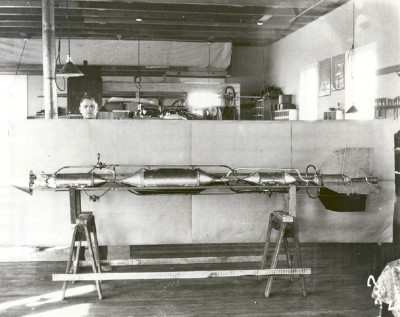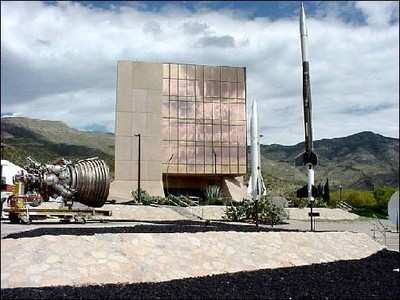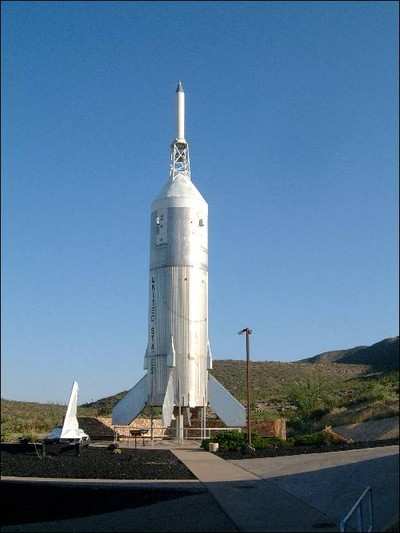New Mexico Has A Long Rocket History
Rockets and deserts go together, and Bill Richardson, the
governor of New Mexico would like it very much if it were his
particular stretch of the desert that emerged as the epicenter of
the new space industry.

Certainly the American Southwest is shaping up to be to personal
space travel what Silicon Valley and Seattle have been to personal
computing. From the prickly libertarian nest of Mojave Spaceport
(or even from near-urban Poway, where SpaceDev is) across a wide
crescent of sparsely populated, arid badlands to the scrubland of
West Texas, a new industry is growing on terrain most Americans
known only from Road Runner cartoons.
But New Mexico has its claim in, and it is a claim of unusual
depth: for not only have the local politicians effectively promoted
their state and done some practical things to boost its utility,
the state even has quite a history of rocketry. Indeed, New
Mexicans claim that their state is the birthplace of American
rocketry.

It is very close to being so, for when noise and risk caused Dr
Robert Goddard's Massachusetts neighbors to rise up against him,
the secretive Worcester Polytechnic Institute professor decamped to
Roswell (yes, THAT Roswell) to continue his experiments. While it's
true that the first successful flight of a liquid-fueled rocket
took place at Goddard's aunt's farm in Auburn, MA, his largest and
most advanced rockets flew (or failed) in Roswell.
His New Mexico neighbors, who were not so near as the
Massachusetts ones, liked him very much, and he wound up neglecting
his physics department so badly that the school closed it on
him.
In 1946, a new group came to the desert to fire rockets, men who
spoke accented, or no, English. Their lack of English language
ability didn't hold them back much, as their rockets came from
their native Germany.

Wernher von Braun, Walter Dornberger and others from the German
V-2 program ultimately assembled and launched 64 V-2s (the
yellow-and-black one is the first one fired here) and many
derivative rockets at White Sands until 1952, when the Army moved
its missile research labs to Alabama. Most of the German scientists
would go on to take American citizenship and join the space
program.

The missile that looks like a V-2 with wings -- in black and
white on May 19, 1950, and in color today -- is a Hermes A-1. It
was intended to be an antiaircraft missile. The test gantry, built
for V-2s, still stands at Launch Complex 33 on the White Sands
Missile Range; it's now a national historical site. The Hermes
missile, the sole survivor of six built, is on loan from the
National Air and Space Museum.
After von Braun and the others left, missilery continued at
White Sands until missiles got so big they could not be contained
in the range fan anymore -- then the government moved to oceanic
ranges. (The Pacific is emptier of human life than even the
desert). Smaller rockets are still tested at White Sands regularly,
and the range itself has seen many upgrades to observation and
monitoring facilities.
White Sands was not the only significant base in the government
rocketry era. Holloman Air Force Base was the home to the legendary
rocket-sled acceleration-deceleration tests of the 1950s. It's also
where NASA's astro-chimps were trained.
The history of New Mexican rocketry has a museum of its own, the
New Mexico Museum of Space History in Alamogordo, including an IMAX
theater, an outdoor rocket display, and the International Space
Hall of Fame. Other rocket-history attractions include a Missile
Park and the above-mentioned National Historical Site at White
Sands and Goddard-related exhibits, including a complete
reproduction of his workshop with many original rockets and
instruments, in a museum in Roswell. There are also attractions
dedicated to fictional spacefarers: the legendary aliens of
Roswell, too, are part of New Mexico's space history.
Today, a new generation of rocket scientists are descending on
New Mexico, drawn in part by commercial imperatives: the low
business costs and favorable regulatory climate, compared to
California for example.
Some government incentives also help: New Mexico is spending $10
million on Spaceport construction, and New Mexico State University
at Las Cruces is starting an Aerospace Engineering program, to
produce the talented people that space companies will need.

But the lion's share of the credit must go to the desert. It's
the desert offers arid, and therefore usually clear and stormless,
air. It doesn't hurt that the new Spaceport is already 4,600 feet
above sea level, at a useful latitude of 32.3 degrees N; but
without the desert climate, it wouldn't be the ideal rocketry
location that it is.
It was the desert, after all, that brought Goddard. And it's
been bringing them ever since.
 ANN's Daily Aero-Linx (04.15.24)
ANN's Daily Aero-Linx (04.15.24) Classic Aero-TV: 'No Other Options' -- The Israeli Air Force's Danny Shapira
Classic Aero-TV: 'No Other Options' -- The Israeli Air Force's Danny Shapira Aero-News: Quote of the Day (04.15.24)
Aero-News: Quote of the Day (04.15.24) Airborne 04.16.24: RV Update, Affordable Flying Expo, Diamond Lil
Airborne 04.16.24: RV Update, Affordable Flying Expo, Diamond Lil ANN's Daily Aero-Term (04.16.24): Chart Supplement US
ANN's Daily Aero-Term (04.16.24): Chart Supplement US







